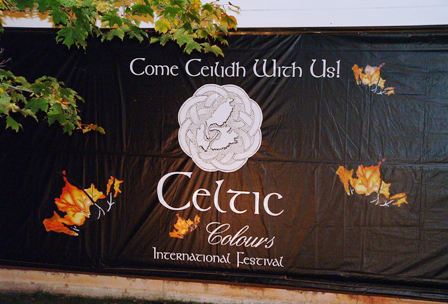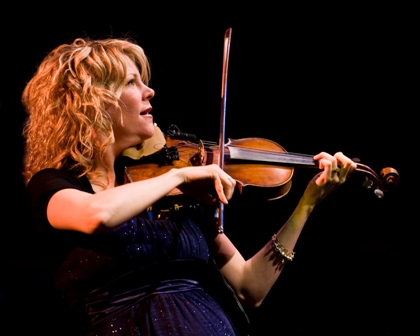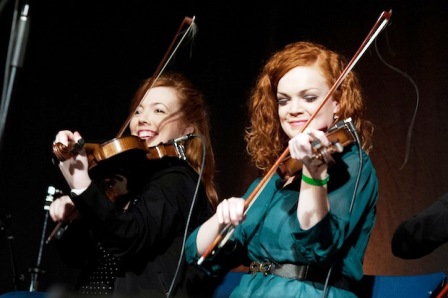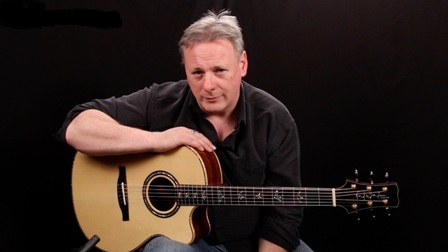Celtic Colours Turns Twenty!
 In small towns, rural harbours and picturesque villages, traditional Cape Breton musicians are getting ready to host their cultural counterparts from around the world for the 2oth edition of Celtic Colours International Festival (CCIF).
In small towns, rural harbours and picturesque villages, traditional Cape Breton musicians are getting ready to host their cultural counterparts from around the world for the 2oth edition of Celtic Colours International Festival (CCIF).
Gifted musicians from Japan, Russia, Spain, Scotland, Ireland, Wales, the Isle of Man, the United States and seven Canadian provinces will cross the islet’s Canso Causeway to the place so poignantly penned in the lyrics of Kenzie MacNeil’s Cape Breton anthem, “ We are an island, a rock in the stream, we are a people as proud as there’s been.”
Visiting artists will perform with the region’s fiddlers, pipers and dancers in communities along the famed Cabot Trail. Amidst ocean vistas and old-growth forests, by the picture-perfect Bras d’Or Lakes and along the Fleur de Lis Trail, all will be united by the transcending language of music for nine crisp days and starlit nights from October 7 to 15.
Scottish singer, songwriter and composer Dougie MacLean, Irish fiddler Liz Doherty and Galician piper Carlos Nunez are among the international artists appearing at this year’s festival. Fiddlers Natalie MacMaster and Ashley MacIsaac, Gaelic singer Mary Jane Lamond, and pianists Doug MacPhee and Mac Morin will comprise part of the Cape Breton contingent. The Unusual Suspects, the festival’s largest act, is richly international in scope; a 28 member Celtic folk orchestra arranged and directed by Scottish musicians David Milligan and Corinna Hewat, with help from Cape Breton’s Allie Bennett.
CCIF’s marquee attractions may be the 49 concerts staged all across the island, but the festival also includes over 250 cultural events and exhibits, and more than 50 community meals where visitors can sit elbow to elbow with Cape Bretoners, enjoying home cooking and warm hospitality, often forging lasting friendships over seafood chowder, fishcakes or a Thanksgiving turkey dinner. In keeping with the island’s predominantly Celtic heritage, many concerts and events take place in Gaelic-named communities like Boisdale, Inverness, Iona and Glendale. The gathering also honours the region’s French and Mi’kmaq roots, with activities scheduled for the villages of Belle Cote, d’Escousse, Eskasoni and Membertou.
Twenty odd years ago Celtic Colours International Festival was the magnificently ambitious dream of Cape Breton musicians Joella Foulds and Max MacDonald, a pair of strategic thinkers with deep convictions. Today it is an internationally renowned festival that brings $11.5 million to the island economy each autumn.
In 2015, 20,568 tickets were sold, representing 88 per cent of total capacity. The festival featured 405 artists, 77 per cent of them from Cape Breton, and staged 47 concerts and 268 workshops or events in 33 different communities. Festival-goers came from all 50 of the United States, all Canadian provinces and territories, and 31 other countries.
 To commemorate its 20th anniversary, this year’s festival will present themes of both remembrance for things past and hopes for the future. On opening night, which features the Nova Scotia Symphony Orchestra, tributes will be paid to departed musicians Buddy MacMaster, Jerry Holland, John Allan Cameron, Raylene Rankin and Rita MacNeil.
To commemorate its 20th anniversary, this year’s festival will present themes of both remembrance for things past and hopes for the future. On opening night, which features the Nova Scotia Symphony Orchestra, tributes will be paid to departed musicians Buddy MacMaster, Jerry Holland, John Allan Cameron, Raylene Rankin and Rita MacNeil.
“These are artists known throughout Cape Breton and beyond by their first names,” says Foulds, who will be performing the tribute to Rita MacNeil, having been her backup singer for many years. “They were great friends of Celtic Colours so we will remember them and treasure their music.”
The seeds of Celtic Colours were sewn when Foulds and MacDonald teamed up to bring the East Coast Music Awards show to Cape Breton in 1995.
“We were determined to do something more to attract greater attention to Cape Breton music and culture.”
Their research took them to Glasgow’s then fledgling music festival, Celtic Connections.
“We had ideas, but we wanted to see what they were doing,” Foulds notes. “Max and I both met dozens of very generous people and then traded information all the way home. By the time we got back to Cape Breton we had worked out a model for a decentralized rural festival.”
The pair was adamant that the gathering had to incorporate the region’s many small communities where the music and culture had been passed down through families.
“People had come to the town of Sydney to work for generations, but it was in the rural communities that the music thrived. We also knew that a festival in one location would not have the buy-in of the community at large and we needed the support of the whole island.”
MacDonald remembers a pivotal meeting at Celtic Connections when he and Foulds were desperately working the room. He was introduced to Scottish guitarist Tony McManus, who has since become a CCIF favourite.
 “Tony listened to our story and immediately took me to meet Carsten Panduro who was running a music festival in Denmark. Carsten understood the challenges and proved very helpful.”
“Tony listened to our story and immediately took me to meet Carsten Panduro who was running a music festival in Denmark. Carsten understood the challenges and proved very helpful.”
When start-up money for CCIF was not forthcoming, Panduro came to Cape Breton to put his weight behind Foulds’ and MacDonald’s efforts.
“A big imposing guy from away, full of enthusiasm and experience, and on our side,” MacDonald remembers with a smile. “He told the government officials that Cape Breton music was known around the world, and I’ve always thought that is when the tide began to turn in our favour,”
The decision to stage the festival in October was initially made to avoiding competing with longstanding attractions, rather than simply to celebrate the region’s colourful autumn foliage.
“We had summer events like the Broad Cove Concert, which had been running for 40 years, as well as the Big Pond Concert, so we didn’t want to tread on them. We knew we’d have greater credibility if we could build on what they had already created,” Foulds explains, adding she hoped to strengthen the island’s “pride of place.”
Though restaurants and motels in rural Cape Breton traditionally closed after Labour Day, Foulds and MacDonald saw the fall as an extended opportunity for local and area businesses.
“When we considered the wonderful backdrop of the season, that became another piece of the puzzle we were assembling,” continues Foulds. “A few of us came up with the name which we felt reflected our environment and our culture.”
 Foulds and MacDonald could have started small with shows in a few locations and built the event year by year. Instead, they gambled that their grand dream would ignite across the island.
Foulds and MacDonald could have started small with shows in a few locations and built the event year by year. Instead, they gambled that their grand dream would ignite across the island.
“The artists were with us, but we were sensitive to people not recognizing gold in their own backyards,” explains MacDonald. “We had to demonstrate to friends and our neighbours that our artists were world class.”
They mustered together 26 concerts for the inaugural festival in 1997, and opening night is still seared into MacDonald’s memory.
“The great Irish musician Sharon Shannon came on stage and began to play. There was dead silence, no reaction, and I knew the audience was filled with a whole bunch of ‘Show Me’ people. Then, slowly, feet began tapping and by the end of her first set people were screaming. It was in that moment that I knew Celtic Colours was born and would live.”
Looking back, Foulds is grateful to the festival’s early supporters and volunteers.
“Our learning curve was so great and our resources so limited. We relied heavily on friends and friends of friends. We’ve never lost our reliance on volunteers, but we got better at organizing through the years.”
McManus, who came from Scotland to play at the second Celtic Colours and was later an artist in residence, remembers connecting with the Cape Breton delegation in Glasgow.
“There was a great meeting of musical cousins with various Rankins and Barra MacNeils making their presence felt at the festival in Glasgow. There was a buzz in the air even then that a big festival was in the works for Nova Scotia.”
Former Nova Scotia premier, and now CEO of Colaisde na Gaidhlig – Cape Breton’s Gaelic College – Rodney MacDonald, recalls step dancing at a CCIF concert in Mabou that first year.
 “There was great excitement around the idea of Celtic Colours. We knew it could be the beginning of something but we could never have imagined the reach that the event would have.”
“There was great excitement around the idea of Celtic Colours. We knew it could be the beginning of something but we could never have imagined the reach that the event would have.”
He watched in awe as champion Scottish fiddler Alasdair Fraser worked his musical magic at that show.
“To have a great fiddler from outside our own community, someone who’d come from a great distance, to play for us and with us, was something most of us had never experienced.”
Other performers that night were teenage fiddlers and step dancers Dawn Beaton – now artistic director of CCIF – and her sister Margie.
“We’d been doing Mabou concerts for years but there was a noticeable change in the air,” shares Dawn, who will perform with her sister this year at two shows at Fortress Louisbourg, a partially restored 18th century French command post that is now an historic site. “In the following years we had opportunities to meet and play with performers we’d never had before. The world opened up for our musicians.”
That first festival brought $3 million to Cape Breton, more than enough to recharge organizers.
“We were exhausted and elated,” says Joella Foulds. “Nobody could deny it was a success. Celtic Colours had actually put our people on an international stage and given them exposure to musicians around the world.”
Through two decades audiences have enjoyed a wide range of music, including Irish, Appalachian, Nordic, Cajun, and much more.
“It was not always familiar music,” smiles Foulds, “but people opened their ears and minds and hearts to it and that has been so encouraging.”
As always, this year’s line-up is as varied as the venues that host the concerts, which include community centers, churches, fire halls and performance centers. Among the first shows to sell-out are those at Fortress Louisbourg. “Step into the Past” features a period meal, followed by a lantern-lit walk to the beautiful chapel in the King’s Bastion where an acoustic concert takes place by candlelight. A second show, “Music of the Night”, offers a similar meal and stroll through the fortress grounds where music spills out of a tavern and stories of rum-running are told around a wood fire.
This year, CCIF coincides with the 50th anniversary of the iconic Men of the Deeps who will perform in their customary overalls and pit helmets. Formed as a choir of working and retired coal miners to convey the toil and solidarity of those who ply their trade underground, the group has nine albums to its name, and is the subject of two National Film Board of Canada documentary films.
Also celebrating its 50th anniversary is Cheticamp’s Doryman Pub. “Fiddlers’ Homecoming: Fifty Years at the Doryman” will pay homage to the longstanding bar, and remember three of the Acadian fishing community’s finest fiddlers, Marc Boudreau, Arthur Muise and Joe Cormier.
 Celtic folk orchestra The Unusual Suspects had its origins in Scotland in 2003 and musical directors Corrina Hewat and David Milligan were thrilled when all 33 members were invited to CCIF the following. Hewat called the invitation a brave move on the part of Foulds, and admits they wondered if they could recreate the jazz and folk blend with Cape Breton and visiting musicians. Happily, they managed to do just that in 2004 and 2006, and again have high hopes for this year.
Celtic folk orchestra The Unusual Suspects had its origins in Scotland in 2003 and musical directors Corrina Hewat and David Milligan were thrilled when all 33 members were invited to CCIF the following. Hewat called the invitation a brave move on the part of Foulds, and admits they wondered if they could recreate the jazz and folk blend with Cape Breton and visiting musicians. Happily, they managed to do just that in 2004 and 2006, and again have high hopes for this year.
“We have fiddlers, pipers, guitar, piano, harp, flutes, accordions, a jazz horn section and a kicking rhythm section made up of international musicians such as Cape Breton’s own Barra MacNeils, and fiddlers such as Mairi Rankin, Wendy MacIsaac and Andrea Beaton plus Scottish musicians Patsy Reid and Mike Vass and Tom Callister of the Isle of Man,” says Hewat. “From the Irish band Flook we have Sarah Allen and Brian Finnegan on flutes and whistles along with Cape Bretoners Matt MacIsaac and Kenneth MacKenzie, who also play highland pipes and which we just had to have.”
Hewat promises the concert to be “a whole festival in one show,” adding that she and Milligan will pair the folk jazz big band with step dancing in deference to their hosts.
While CCIF opens in a reflective mood, Dawn Beaton notes the closing concert, “A Toast to 20 More!” will be forward-looking.
“We’ve deliberately chosen a wide range of young, contemporary musicians, from our own region and beyond, to symbolically look toward the future, to hint at what the years ahead may look like. The show will explore the particular slants these creative musicians bring to traditional music, including a taste of Gaelic rap.”
It will be a meeting of hard-driving traditional fiddler Ashley MacIsaac and Scotland’s Griogair Labhruidh, aka G-Croft, a core member of the popular fusion collective, Afro Celt Sound System. Descended from long lines of pipers, Labhruidh is a master piper, guitarist and Gaelic singer who recently collaborated with composer Bear McCreary to produce music for the hugely popular Outlander television series.
Slainte Mhath, a Cape Breton band that toured internationally for a decade, is reuniting for the closing concert which will also feature Le Vent du Nord, a Quebec-based roots band. Joining them will be multi-instrumentalist J.P. Cormier – who claims to have never missed a festival and never will – along with the Gaelic College’s Nuallan Pipers, Michigan-born step dancer Nic Gareiss and the island’s Fileanta step dancers.
In assembling their shape-shifting puzzle of a music festival, Foulds and MacDonald relied on the intrinsic kinship with past musical tradition, the willingness of islanders to roll up their sleeves for what they hold dear, the lure of the island’s scenery and the natural hospitality of its people. This combination saw them through their first year, was not diminished when MacDonald left eight years ago, and remains strong today.
 Piper Kenneth MacKenzie knows that the measure of a Cape Breton piper has traditionally been his ability to play for dancers, a standard recognized in this year’s Pipers’ Ceilidh.
Piper Kenneth MacKenzie knows that the measure of a Cape Breton piper has traditionally been his ability to play for dancers, a standard recognized in this year’s Pipers’ Ceilidh.
“It is always an honour to perform there but especially this year since it is honoring both Alec and Duncan Currie. Alec was an amazing dance piper from Cape Breton and was an uncle to John MacLean, one of the biggest influences on my piping and someone I admire a great deal, while Duncan Currie was a relative of mine from South Uist, through my father.”
There is scarcely a back road in Cape Breton that Dan MacDonald has not travelled to get to one concert or another in the past two decades. For many years he was a stage manager for a concert every night, his wife Vonnie assisting and then taking over site management.
“It is still exciting after 20 years. We get to hear the music right up close, get to know the musicians and see them year after year.”
“We love the new acts or new combinations that rock the venues,” he continues. “We love the audience reaction, particularly from those who are attending for the first time. Magic happens here.”
For Tony McManus, who now lives in Canada, the beauty of Cape Breton Island is matched by the value its people put on their music.
“The physical setting is stunning and there is a pride in the music and an appreciation of those who make it a part of the fabric of life on the island.”
CCIF, he believes, is more than a great festival; it goes a step further by “investing in musicians” – giving them an opportunity to stretch their skills with commissioned work, new collaborations and original compositions.
“Joella and Max had a dream of how the musical culture of the island could serve as a platform for an exceptional and uplifting event. They have succeeded hugely in realizing that dream and now it is one of the best events on any traditional musician’s calendar. It’s a good year when I’m asked back and this will be a good year.”
Front row centre at many CCIF concerts is a group of animated women waiting for the music to start. They are the MacInnis sisters, the daughters of the late Cape Breton fiddler, Dan Joe MacInnis of Big Pond. Arriving early secures them not only front row seats but the chance to talk to concert-goers.
“We love the entertainment, both the traditional and not so traditional, like Daniel Lapp playing Celtic music on a horn. But we also love to hear how visitors are enjoying our island.”
MacPhee has been known to invite visitors and artists home for a cup of tea or a ceilidh.
“One year a young couple from Australia or New Zealand sat with us and asked us where they could get a real Cape Breton Thanksgiving dinner. I gave them my sister’s address because we’d all be there and there would be plenty of food and music. We had a great time together and Celtic Colours has brought us many friends.”
It’s those kinds of experiences that Joella Foulds will miss most when she resigns her position after this year’s gathering.
“I’ll go with an easy heart, knowing it is in good hands. Twenty years of Celtic Colours – that is an accomplishment for all of Cape Breton to celebrate.”


















